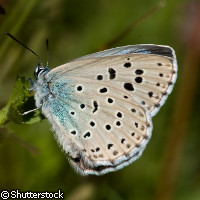Invading butterflies trick ants with sounds
A team of Italian and British researchers has found that queen ants make distinctive sounds inside ant colonies. But even more interesting is that a species of caterpillar about to transform into a butterfly can deceive worker ants into allowing them to enter their colony, as well as keeping them fed and cleaned, by mimicking the host ant's acoustics. The results of the research study were recently published in the journal Science. The researchers from the University of Turin (Italy), the Centre for Ecology & Hydrology (UK) and the University of Oxford (UK) discovered a crafty tactic employed by a group of caterpillars on their journey to becoming butterflies. Caterpillars belonging to the butterfly species known as the Rebel's Large Blue infiltrate an ant's nest by tricking ant workers into giving them access to their colony. This takes place despite the fact that ants live in complex societies with developed communications systems, and are known to be big defenders of their colonies. Once this happens, the caterpillars gain up to 98% of their ultimate weight within the host ant colony before forming pupae and transforming into butterflies between 11 and 23 months later, the research team said. 'Earlier research had shown that social parasites like the Rebel's Large Blue caterpillar secrete semiochemicals and use begging skills in order to infiltrate host ant colonies,' explained Dr Francesca Barbero from the University of Turin and lead author of the study. 'Our new work shows that the role of sound in information exchange within ant colonies has been greatly underestimated, and that acoustical mimicry provides another potential route of infiltration for the 10,000 species of social parasites that exploit ant societies.' The researchers produced a special microphone and used recordings to play back the calls of Rebel's Large Blue caterpillars to the nests of its host ant workers. Based on the results, once an intruding caterpillar gains access and is accepted as a member of the host ant society, the mimicking of adult ant acoustics (and particularly those of the queen ants) gives the caterpillar the boost it needs to climb the social ladder and secure one of the top positions of the colony's hierarchy. 'Our experiments showed that in response to the caterpillar's sounds, the worker ants protected them in a similar way to how they protect their own queens,' said co-author Dr Karsten Schönrogge from the Centre for Ecology and Hydrology. 'The use of these distinctive signals reinforces a higher social status for both queen ants and the Rebel's Large Blue caterpillars. This higher status becomes vitally important to survival when food is short.' Professor Jeremy Thomas, currently at the University of Oxford, conducted a study in the past showing that despite a disturbance in an ant colony, the ant workers will rescue the caterpillars before they protect the ant larvae. The study also found that nurse ant workers won't hesitate to kill their offspring and feed the social parasite if there isn't enough food. 'This study is the final piece of the jigsaw towards understanding how the Rebel's Large Blue caterpillars can out-compete their host ant's larvae,' remarked Professor Thomas. 'The new findings will play a key part in designing a successful science-led conservation strategy for this fascinating species,' he added. 'Any such strategy must be based on an excellent understanding of the intimate interactions between the butterfly and its ant host.' The Rebel's Large Blue butterfly is on the endangered species list because of changes to its habitat. According to the researchers, the butterfly is restricted to a small number of meadows within mountainous areas of Europe where a specific type of ant co-exists with the gentian plants needed by the young caterpillars.
Countries
Italy, United Kingdom



